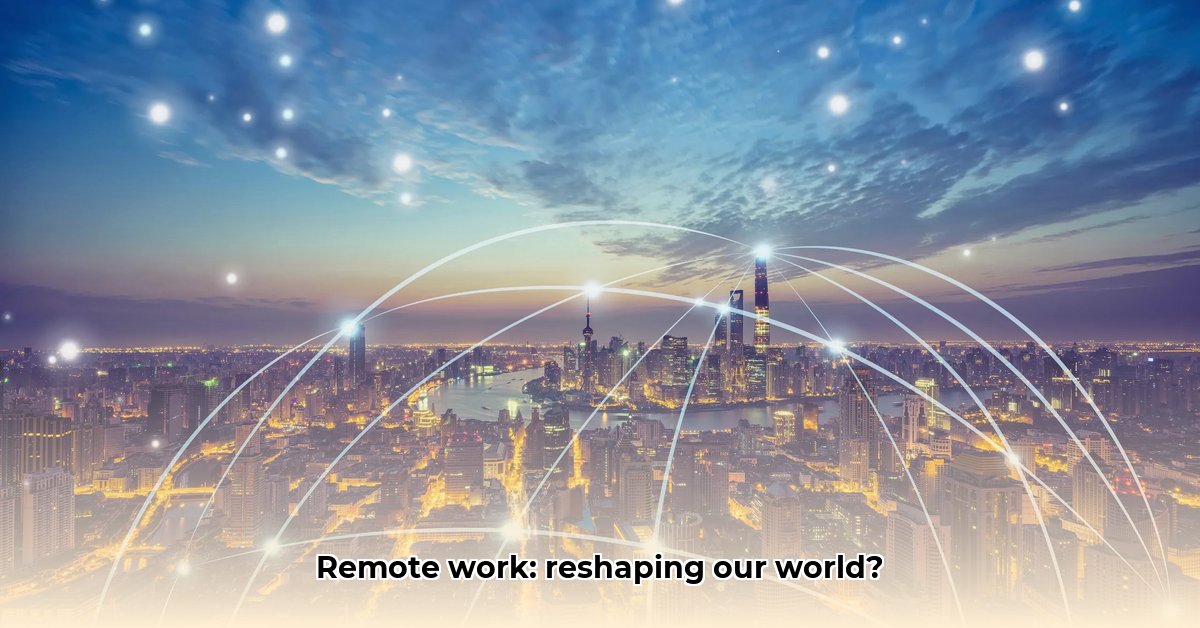Do you remember the sudden shift when the pandemic hit? Seemingly overnight, remote work became the norm. This change wasn’t just a temporary adjustment; it has fundamentally reshaped how we live and work, significantly altering our cities and economies. This transformation extends beyond individuals working on laptops from their homes. It encompasses the growth of towns due to location independence, the evolution of company management of remote teams, and the adjustments governments are making to adapt. For a look at long-term geographical shifts, see geographical changes. We will explore how this major shift impacts housing, business strategies, and location preferences. This exploration aims to simplify a complex situation and clearly demonstrate how the evolving world of remote work affects you.
The Future of Remote Work: How It’s Reshaping Our Cities and Economies
The pandemic accelerated the adoption of remote work unexpectedly. A concept previously considered unconventional quickly became standard practice for millions. Commutes decreased dramatically, offices became less populated, and cities began to transform. This change is not just temporary; it represents a fundamental shift, profoundly affecting our lives by reshaping our cities and economies in ways that are still unfolding. Let’s delve into this transformation to understand the extent to which remote work will redefine our societies.
Housing Market Trends and Remote Work
The housing market vividly illustrates the extensive effects of remote work. Consider this: Individuals, who previously needed to live in expensive cities to earn higher salaries, now have the opportunity to live and work anywhere with reliable internet access. This shift has significantly increased demand for housing in suburban and rural areas, causing a surge in prices. Certain smaller towns are thriving, while others struggle to keep up. This trend not only benefits real estate agents but also fundamentally changes residential preferences. However, the sudden influx of residents and capital can inflate rents and home prices, potentially displacing long-term residents and exacerbating community inequalities. The sustainability of this growth and its equitable distribution, particularly for long-term residents, remain critical questions.
Boosting Productivity in the Remote Workplace
The impact of remote work on productivity is a frequently debated topic. Some assert that it enhances focus and efficiency, while others worry about the challenges of collaboration and the difficulty of separating work from personal life. The solution requires more than simply providing employees with laptops; companies must proactively foster robust communication, offer comprehensive support, and implement strategies to maintain productivity and engagement. This includes developing methods to assess success in a remote setting, which should encompass qualitative measures beyond just hours worked. The key is to mitigate the potential for isolation and sustain team unity. Is presenteeism truly superior to efficiently executed remote work?
Adapting Cities to the Remote Work Revolution
Cities, once the central hubs of economic activity, are now grappling with the consequences of reduced commuting to traditional offices. Vacant office buildings highlight the evolving urban landscape. Many cities are actively seeking innovative ways to repurpose these spaces, converting them into apartments, mixed-use facilities, or community centers. The main challenge is adapting and reinventing these urban areas to attract and retain residents in an era defined by flexible work arrangements. Will cities embrace this transformation as an opportunity, or will they struggle to keep pace with the swift changes reshaping urban environments?
The Role of Governments in the Future of Remote Work
Governments are crucial in managing the transition to remote work. Ensuring reliable, high-speed internet access is essential to prevent a digital divide. Addressing the issue of affordable housing in rapidly growing areas is also vital. Additionally, adjustments to tax policies and public services are necessary to accommodate a more geographically dispersed population. The objective is not only to react to the changes but also to actively shape the future of work and foster a more equitable environment. What visionary policies will lawmakers implement to ensure equal opportunities for all, leaving no community behind in the digital age?
Economic Inequality in the Remote Work Era
While sectors like tech and finance have adapted smoothly to remote work, industries such as healthcare and manufacturing encounter significant challenges. This difference raises concerns that existing economic disparities may widen. Support for those struggling to adapt is essential to ensure opportunities for everyone to thrive in the evolving economic landscape. How can we ensure a level playing field and prevent the development of a two-tiered system, especially considering the unequal distribution of remote work opportunities?
Uncharted Territory: The Unknowns of Remote Work
The future of remote work remains largely uncertain. Key questions persist regarding the evolution of social interactions, the long-term effects on mental health, and the promotion of inclusive economic growth. Addressing these challenges also offers opportunities to reimagine work, community, and urban structures. The narrative is still unfolding, and the decisions made today will determine the realities of tomorrow.
A Path Forward: Collaborative Action
The following table outlines actionable steps for various stakeholders:
| Stakeholder Group | Short-Term Actions | Long-Term Strategies |
|---|---|---|
| Governments/Policymakers | Invest in broadband infrastructure; address housing affordability issues; review tax structures. | Implement sustainable urban planning initiatives to mitigate geographical inequality; Invest in workforce retraining programs. |
| Employers | Explore hybrid work models; invest in remote work technologies; improve communication strategies. | Re-evaluate office space needs; adapt performance management systems to focus on outcomes. |
| Remote Workers | Establish clear boundaries between work and personal life; invest in creating a productive home office environment. | Consider upskilling to remain competitive; carefully weigh the pros and cons of living in urban vs. rural areas. |
| Urban Centers | Repurpose commercial real estate into residential or mixed-use developments; invest in improved public transportation and infrastructure. | Diversify economies; enhance quality of life to attract talent and residents. |
The shift towards remote work is complex and multifaceted. Continued research will refine our understanding of its effects over time. This is just the beginning of the transformation.
Addressing Employee Mental Health in Remote Work Environments
Remote work presents a paradoxical situation, offering notable flexibility while potentially undermining mental well-being. How can we maximize the benefits while minimizing the drawbacks, especially as remote work continues to reshape cities and economies?
The Hidden Costs of Remote Convenience
The advantages of working from home—no commute, relaxed attire, and improved work-life balance—are appealing. However, this can mask challenges like increased isolation, blurred boundaries, and the pressure to be constantly available. Research consistently shows a link between remote work and heightened feelings of loneliness and burnout. Without intervention, these issues can reduce productivity, increase employee turnover, and diminish workforce engagement, which in turn affects the economies of cities.
A Holistic Approach to Remote Workplace Well-being
Alleviating the negative impacts of remote work on employee mental health requires a comprehensive strategy involving employers, employees, and policymakers. This strategy moves beyond providing laptops and focuses on cultivating a supportive environment promoting well-being.
Employee Strategies: Reclaiming Control of Mental Well-being
- Designate a Workspace: A dedicated home office helps to psychologically separate work from leisure.
- Establish Clear Boundaries: Set definite start and end times to maintain a healthy work-life balance.
- Prioritize Self-Care: Schedule regular exercise, hobbies, and social activities to build mental resilience.
- Embrace Virtual Socialization: Schedule virtual coffee breaks, join online communities, and actively seek social interaction to proactively combat isolation.
- Seek Support: Consult mental health professionals when needed.
Employer Strategies: Building a Supportive Remote Culture
- Invest in Communication: Use various communication channels to ensure consistent information flow and connectedness.
- Provide Mental Health Resources: Offer Employee Assistance Programs, mental health workshops, and access to telehealth services.
- Promote Flexibility: Offer hybrid or flexible work options to accommodate individual needs and circumstances.
- Train Managers: Provide managers with the skills to effectively support remote teams, emphasizing empathy, clear communication, and regular check-ins.
- Cultivate Open Communication: Encourage employees to openly discuss mental health concerns without fear.
Policymaker Roles: Fostering a Healthy Remote Workforce
- Invest in Research: Fund research on the long-term effects of remote work on mental health.
- Develop Guidelines: Create guidelines and best practices for supporting the mental well-being of remote employees.
- Address Inequalities: Ensure remote work policies address potential disparities that could worsen mental health challenges.
Key Takeaways:
- Remote work provides significant opportunities but also introduces mental health challenges.
- Mitigating the negative effects requires a coordinated effort from all stakeholders.
- Proactive strategies are essential for addressing isolation, burnout, and boundary issues.
- A supportive environment is crucial for a thriving remote workforce.
- Prioritizing mental well-being is an investment that boosts productivity and employee retention.
- Robot Reporters: Ethics of AI in Journalism; A Guide to Trust - August 3, 2025
- Astonishing Savant Memories: Unlocking Brain Secrets Now - August 3, 2025
- Quantum Entanglement Explained: Einstein’s Spooky Action & Tech Revolution - August 3, 2025













